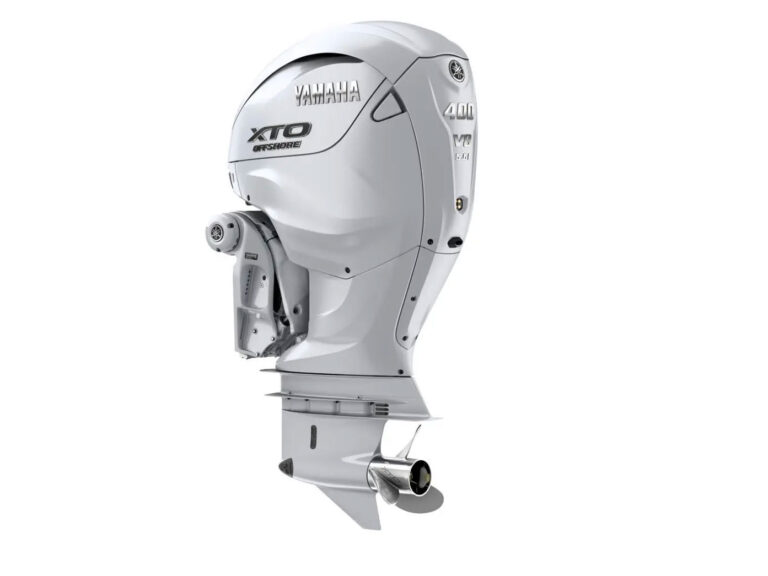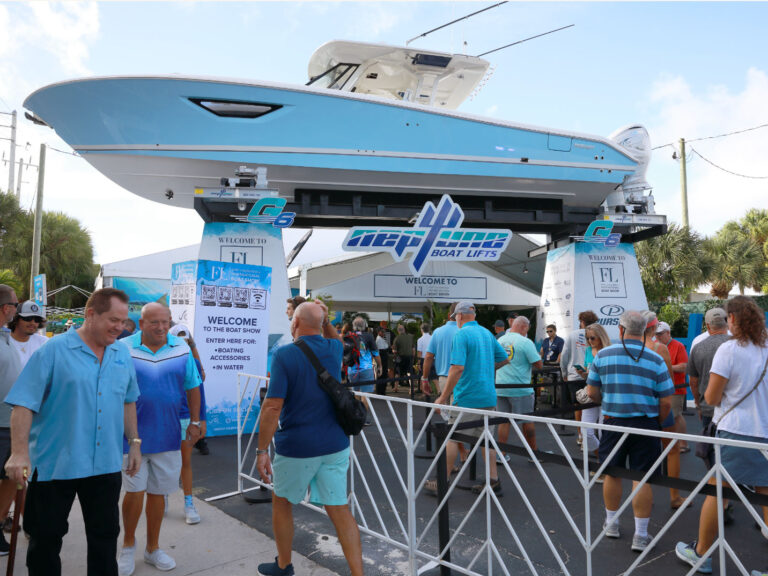Editor’s Note: This report was published in 2002. It was one of our first tests of joystick engine controls. Though some of the equipment and systems cited are non-current, the maneuvering advice remains as relevant today as it was then.
An alpha dog, he possesses the aura of intimidation common to NFL linebackers, prizefighters, and after-hours club doormen. Though he’s never docked a boat before in his life, his skill with a joystick is legendary. But he has a math test tomorrow-and his father made him come-so he’s in no mood to fool around.
David Rumplik, 12, wants to show this old salt a thing or two. Armed with Maxum’s Control Max system, Rumplik says he’ll be able to dock a boat with the ease and grace of a seasoned skipper, no experience necessary. With half a lifetime of conquering PlayStation bad guys, The Kid is a master at dealing with pressure. The gauntlet has been thrown down, the challenge is on.
Though I have nearly 30 years of seamanship under my belt, I’m not as confident. Catching sight of a flag onshore, my mind races. Is the wind steady or was that a gust? Which way is the current moving? How tight is the space into which I have to shoehorn this shiny, new, still-smells-like-styrene Maxum 2300? Are my skills with wheel, throttle, and gears up to the task? After a week of taking bets and testosterone buildup, my mouth now smacks with the metallic flavor of fear. My palms are sweaty as I turn to The Kid’s father hoping for a reprise. But no, he’s made his bets, too. He flashes me a wicked grin and fires up the engine. We slip the lines and head for a marina exposed to winds and waves. Let the dance begin.
Back Into a Slip, Wind Abeam. The Kid: Eyes aft, he pulls the Control Max’s doorknob-shaped joystick back and to the side to correct his course. The twin stern thrusters mounted in the Maxum’s hull hum and the boat heads for the slip. Whenever the bow starts to drift downwind, a twitch of the joystick activates the bowthruster to bring it back in line. All is going well until we get close to the slip. With the neighboring boats and a pair of pilings looming larger, The Kid begins to get nervous. He almost chokes, but with a little encouragement from his dad (I was giving him no quarter), he comes to a perfect stop just a foot from the bulkhead.
The Salt: With the stern lined up with the slip, I bump the Bravo Three drive alternately into reverse and neutral, cautiously inching backward. The rule is: Never approach a dock faster than you want to hit it. The counter-rotating props back straighter than a standard drive because each prop negates the side thrust of the other. A gust hits the bow, which is always more susceptible to the wind’s influence than the stern, pushing it downwind. But it’s not a problem, as I purposely started my approach with the bow canted into the wind by about 10 degrees. As the boat backs, the wind pushes the bow over so I’m almost straight by the time I get to the pilings. I make minor course corrections while in gear, but larger ones-such as those needed to get the bow back in line-I make by shifting to neutral, turning the wheel, and then applying power again. Slow and gentle are my watchwords. And, because of the confidence bred from experience, the pilings don’t intimidate me the way they did The Kid. I’m a full 20 seconds faster, handily winning the round.
Back Through a 90-Degree Turn Into a Slip. The Kid: His confidence with the Control Max’s triple thrusters is becoming evident. He backs straight until the slip is abeam of our transom, then spins the bow and backs in with the aplomb of a charterboat veteran.
The Salt: Backing through a turn requires the same techniques as going straight, with just one little wrinkle. The key is remembering that, unlike cars, boats steer from the stern. That’s why I back down slightly past our space and line up the Maxum’s swim platform to the bow of the boat in the far slip. I click into forward to check my rearward motion, then shift into neutral. I turn the wheel away from the slip and into forward again. Minimal throttle, simply idling in gear, is the best speed for virtually every docking situation. With the wheel hardover, the stern swings in toward the slip. I stop with a short burst in reverse when lined up. Shift into neutral, turn the wheel to straighten the drive, and proceed to back in as before. Time-wise, it’s a tie.
Dock Side-To, Between Boats, Onshore Wind. The Kid: He’s bored, doing a Jackie Mason shtick from a Honda TV commercial for its four-wheel-steering cars: “You shouldn’t believe such a thing. Da back goes dis vay, da front goes dat vay, the boat goes sidevays. Oy vey.”
The Salt: Although this situation may seem like a hair puller, it’s not. Remember, the wind is your friend. Here’s why: I simply pull up slowly alongside the space between the two boats and let the wind push me in. A little bump in forward, a little in reverse to stay positioned between the boats, plus a little patience, is all I need. It takes me 15 seconds to the kid’s 5, but so what?
Getting Underway, Onshore Wind. The Kid: Now he’s yawning and whining to his dad about when they can leave. He pushes the joystick to port and goes out sideways.
The Salt: I’d normally accept a push from the dockboy and some fending off from my crew in this situation. But that isn’t acceptable in this exercise. Knowing that a boat steers from the stern is the key to unlocking this puzzle. With the drive in neutral, I cut the wheel away from the dock. Then I shift into reverse-idling only-until the stern clears the boat behind me. I then straighten the wheel slightly, backing out past that boat. Clear of the dock and other boat, I put the wheel hardover so the boat pivots around, ending up with the bow pointing out. I shift into neutral, let the bow continue to swing, and straighten the drive. When the bow is pointed seaward, I shift into forward and head out. The Kid got clear in 30 seconds. It takes me…what is time after all? I mean really. Okay, okay. It took me 45 seconds.
Dock Side-To, Between Boats, Offshore Wind. The Kid: The Control Max’s side thrusters let him make a controlled approach and a soft landing, all the while talking to his father about a new computer. This is getting embarrassing. Maybe I should play more video games.
The Salt: This maneuver calls for a steep angle of approach to minimize the effects of the wind. So I head the Maxum in at about 70 degrees to the dock. When the bow is a boat length from the dock, I shift into neutral, turn the wheel hard toward the dock, and shift into reverse. This has two simultaneous effects on the boat. One, it checks its forward motion without stopping completely. Two, it causes the stern to swing in toward the dock. The result is a controlled slide that can be checked at any time by shifting into neutral, because the wind is your friend and will keep you from hitting the dock. The Kid beats me by 10 seconds.
Winning Isn’t Everything. The Kid proved that technology can make up for some lack of experience. Yet I proved that with experience and an understanding of where a boat’s pivot point is, how it steers from the stern, and the effect the wind has on your bow, you can dock anything, anywhere, anytime. All it takes is practice and remembering these three points: Go slow, always know where your drive is pointing, and use the wind. Oh, and one more thing: If you’re a macho boat jockey who likes to keep his ego intact, don’t challenge a kid with a joystick to a docking contest.
Maxum Control. Control Max is simply a bowthruster and a pair of stern thrusters operated by a joystick at the helm. The thrusters are small propellers installed in tunnels molded into the hull below the waterline. Operation is intuitive: Shuffle the joystick in the direction you’d like to go, and the boat responds-forward, backward, even sideways. Easy as pie.
The catch? There are several. For one thing, the system costs $4,000. You could get docking instruction from a professional captain for 1/10 of that. Electrically powered, Control Max runs on a dedicated battery that weighs about 100 pounds. Our experience dictates that adding weight aft affects a boat’s speed and performance. This battery is also a parasite on your engine’s charging system. It requires so many amps that your alternator will take longer to recharge both the Control Max battery and your boat’s primary batteries. Therefore, we recommend a dual starting battery system, in addition to the dedicated battery, for any boat equipped with Control Max. This adds more weight and expenses.
Finally, unlike bowthrusters on large boats, the Control Max propeller tunnels are too small a diameter to get a paint brush into. Therefore, if you keep your boat in the water, fouling will eventually prevent the propellers from turning.
But for the Lotto-winning novice, those who don’t have the time to practice, or even as a safer way of picking up a downed water-skier, Control Max works.









